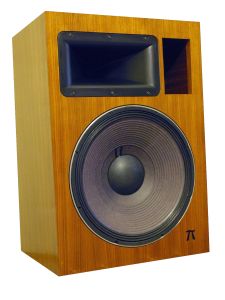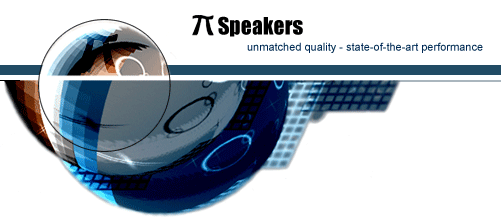 |
Products |
 |
|
|
|
 |
Quick Find |
 |
|
 |
Information |
 |
|
 |
| 0 items |
 |
|
|
 |
Tell A Friend |
 |
|
|
|
|
| four π kit Reviews |
 |
|
 |
| Product: four π kit |

|
| From: Ken Schwarz |
| Date: Monday 18 August, 2003 |
|
| Review: |
In the world of hi-end audio, where it is sometimes hard to tell if the nonsense you read is authored by charlatans or idiots, here's Wayne Parham, a big-hearted and plain-speaking engineer who is happy to give away his ideas and speaker plans. If you're convinced by the merits of his technical arguments and the enthusiasm of his website's following, you can order a kit containing all the necessary parts from his website, including pre-assembled crossovers, for a very reasonable price.
But what would they sound like?
If you are one of those poor, benighted souls who has never heard a good high-efficiency speaker, then it's hard to explain what's possible. The usual setting for such systems is in commercial venues, such as jazz clubs or stadiums. Rest assured, bad honking horn systems need not be the rule; done right they sound very natural. And if you've ever wondered why home speakers don't even sound close to the fullness or intensity of real live club sound, it's because the club is using equipment which normally you wouldn't find available for home applications. Pi speakers are built with the parts that are normally used in clubs, so the potential to get this sound at home is there.
Wayne publishes his engineering design principles in technical documents on his web site. The philosophy of the documents mirror that of his speaker designs: as simple as possible, but no more so. My background knowledge of first-year college physics is essentially sufficient to follow the lines of arguments, and the high-level discussions are easy to understand. Wayne's line of speakers all use the best parts he can find for optimally flat frequency response, uniform directivity, great dynamic range, and low distortion, all done at a surprisingly low price-point.
For the Pi-4 speaker, the secret sauce is a combination of a proprietary bass driver tuning algorithm which chooses optimal box and port volume parameters for a given driver, plus his crossovers which serve dual duty of matching drivers both in volume and in directivity and of compensating for falling response of the treble compression drivers. The recurring themes of his documents and commentary on the web site discussions are that performance is highly predictable from the component properties and design approach, and that for the tradeoffs that Wayne has explicitly chosen, his designs are the best around.
Wayne is unfailingly generous to answer any questions around his designs, and is never bashful to defend his thinking, so from time to time lively and highly readable technical debates around his premises and execution crop up on the forum. Since I had no opportunity to audition the speakers before purchasing them, the open plans and Wayne's vigorous defense of them came to be the most compelling factors for me to actually order the things.
I was already familiar to the sound of a large-format horn speaker with my second-hand pair of JBL 4344 Mk2's, a consumer JBL speaker system sold in overseas markets. This particular speaker is a close design derivative of the JBL 4343, which was actually marketed as a studio monitor in the 1970's and 1980's. The 4344 Mk2 is a 4-way, built from a proprietary JBL 15" woofer, 2123 10" midrange, a proprietary JBL 1" compression treble driver and the 2405 tweeter. The Mk2 was introduced in 1996, and has a loyal following in Japan, but has some anachronistic design features, such as a horn lens instead of a modern wide-dispersion radial horn on the compression driver. Does this matter? That was hard to know without a speaker like a Pi-4 around for comparison. Did the extra bandwidth and unit optimization of a 4-way outweigh the benefits of a simpler (but not simplistic) 2-way with the newest pro parts from JBL? I was dying to find out.
At about $3,000 for parts and construction costs, a Pi-4 is not an inexpensive experiment. On the other hand, I thought that either they or the JBL's would be fairly easy to sell once the matter of which was better for me had been settled.
I ordered my Pi-4 kits with JBL drivers from Wayne. These I figured would be the "best with the most", and indeed they represent the most dynamic and lowest distortion version available. The tradeoff was some additional expense for the JBL woofer. I had the cabinets built by a local carpenter, to Wayne's specification. Except for the binding posts on the back, I used parts supplied. And, except that I forgot to tell the cabinet maker to build the speakers as a mirror pair (fortunately, this turned out to be unimportant), I followed the instructions exactly.
Assembly was a pretty straightforward half-day effort, but there were a couple of hitches. First, the horns (made by Eminence) don't easily fit on the JBL compression drivers. You need to cut away a fair amount of material on the horn mount to make room for the mounting bolt, but no changes to the compression driver are needed. I used a drill to do this and it was a messy nuisance, but nothing terrible. You need to make plenty of room for the bolt because horn/driver assembly has to be done *inside the speaker* and there it's cramped and dark in there!
The other problem is that the Eminence horn lip is shallow, so it requires careful work by the carpenter to cut the hole: there's very little real estate for the mounting screws. Fortunately, all but one of the screw holes held securely, and this was plenty for mounting the horns. Lastly, you must wear gloves, protection goggles and a mask when cutting and installing the fiber glass insulation in the cabinet or risk injury or diseases associated with the material. If any of the above spook you, you can order completed speakers from Wayne at a price that turned out to be comparable to what I paid a carpenter to do the work for me.
One of the benefits of building the speakers yourself is that you can have fun choosing the veneer. My wife and I ended up with a bright-yellow Formica-like material which we felt looked better with the raw drivers than a fancy real wood veneer. I love the look of the yellow speaker, but I suppose that they might limit the speaker?s resale value!
AudioRoundTable.com/PiSpeakers/messages/8296.html
-
In this picture, the wooden port chambers weren't ready, so I glued in cardboard of the right dimensions as a substitute for testing. Otherwise, this is what my speakers look like.
The sound
OK, you heard it here first: this is a high-performance speaker. It doesn't mess around. It has an effortless, uncolored, and unified sound across its rated bandwidth. "Effortless" means that a close-up 20-person choir sounds like 20 people simultaneously singing in your room, which - if you have sung in a choir you know - can be a large amount of sound, but doesn't necessarily feel loud. It is a huge, present, lifelike and convincing sound, and enormously enjoyable. The tempi, lines and musical dynamics of simultaneously played instruments and voices are easy to hear.
The sound is highly intelligible, a quality which pays off in movies where you feel no sense of strain to hear whispered or muttered dialogue. These speakers have 90-degree dispersion and literally spray the room with sound, so they sound much bigger than they are and easily fill a large space. There is plenty of soundstage/depth/imaging/etc. which is always pleasurable enough and on good recordings enjoyable in its own right. Instrumental timbre is surprisingly precise and, honestly speaking, significantly better than that of the JBL 4344 Mk2. Unamplified recorded voices sound "right" in a way that the JBL's don't quite manage. I don't know what causes the differences, but the Pi speakers sound lower in distortion than the JBL's, even if the JBL's offer more bandwidth.
The bandwidth qualification is important. The Pi-4 is a 40Hz-16KHz speaker. Now, that doesn't mean that it sounds weak in the bass. Especially with the solid-state amp, it can easily produce chest-pounding bass, drums and frightening HT effects. Still, there is no denying the fact that it does not have the bottom octave of deep bass, nor does it have the last bit of treble extension that a 20-20K speaker would manage. By comparison 4-way 4344Mk2 is 6db down at 32Hz, and the 2405 slot-tweeter extends high frequencies beyond audibility.
Do the bandwidth limitations matter? In my view, the missing bass is a problem to achieve a natural balance. I have addressed it with an REL subwoofer, which runs in parallel with the Pi-4's, rolling off at 6db/octave from the mid-30s up. The subwoofer integrated beautifully, even if the REL bass is not as taught as that of the Pi-4's. Problem solved.
The missing treble was something I worried about but has turned out to be a blessing on many CDs, where there can seem to be more noise than music in that last 4 KHz. Now, the Pi-4 Pro is a speaker which never seems lacking in sparkle or ambiance - you can hear those little echoes and non-musical noises which make a live recording sound real. At the same time, they are utterly unfatiguing, even when driven by a completely undistinguished $100 DVD player serving as the CD player.
Overall, the spectral balance of the Pi-4 is excellent if you set them up right and sit at the right level. Setting them up right is easy: you should put them on the floor and against a wall. Exactly symmetrical and unobstructed distance to the listening spot is not critical. In my living room, I have set up the HT/stereo rig in the corner, with the speakers about 8 feet out from the corners, pointing at the seating area. If you pull them away from the walls or set them up on stands, they will sound thin in the bass. Great! This means that the speakers do not hog the room.
The speakers have very wide and uniform horizontal dispersion, so you do not need to sit right in the middle to enjoy them and don't need to worry about room reflections resulting in horrible colorations. This makes them uncritical about placement. However, for the best spectral balance, you really do need to sit vertically on axis with them. I've experimented tipping them back, which seems to help if I am sitting in the sofa, but frankly speaking, sitting on the floor is the place to be for nirvana with this system. On the other hand, the fact that the horns are not mounted above the tops of furniture means that the sound is adequately absorbed by furniture in the room and not excessively reflected by bare walls. (This IS a problem for the JBL's, and results in much more difficult spectral balance problems than those of the Pi's, so you can pick your poison.).
Well, this did turn out to be an expensive experiment for me, because I ended up keeping both the Pi and JBL systems, since they each have their own undeniable strengths which I don't want to give up, and it's more fun to have two systems. In my view, the Pi system is the better value: $3000 for speakers, $100 for the DVD/CD player, $1000 for the receiver/integrated amp (I personally would recommend spending $1000 on a used push-pull like the CJ MV-50 and a simple passive pre-amp, but a solid-state HT system like the Arcam works very well, even if it is not as entrancingly lifelike), and $2000 for an REL sub. You could probably build a better sub for your money, but this one definitely does the job. As I said, the sub isn't a requirement, but I do recommend it. I am extremely impressed with my Pi-4's. |
Rating:  [5 of 5 Stars!] [5 of 5 Stars!] |
|
|
|





